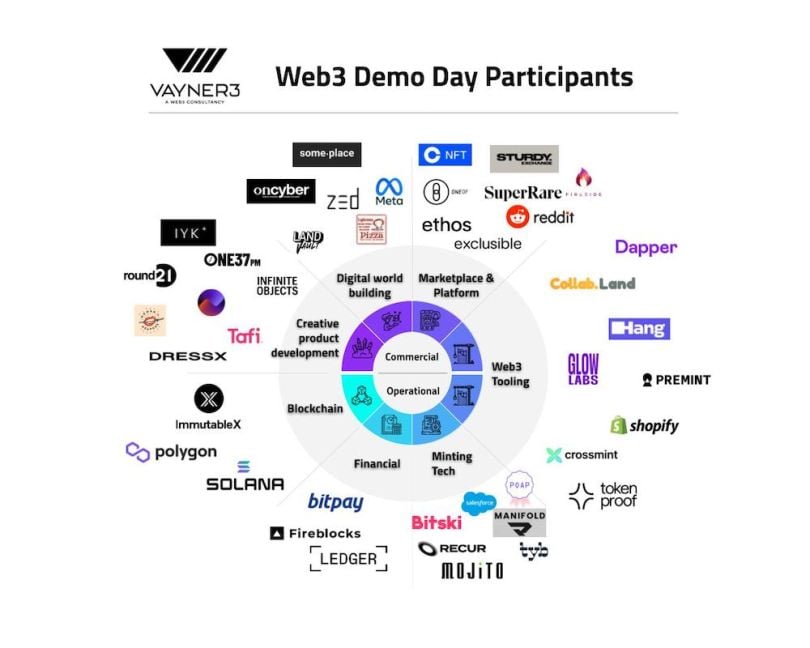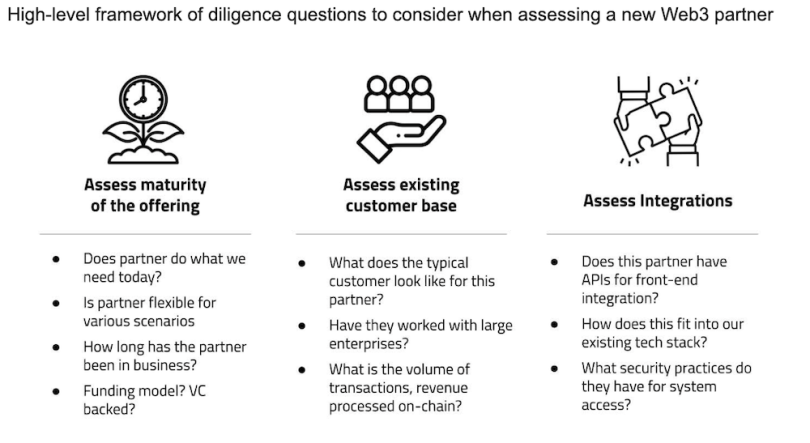2022 is on pace to be another record-setting year in venture capital investment in the crypto, blockchain, and web3 space — investors poured almost $18 billion into the space in the first half of the year alone. This meaningful influx of capital is funding extraordinary innovation. As brands and enterprises continue to see the value in digital ownership and identity (which are core tenets of web3), they will need to develop strong alliances to execute their web3 ambitions. They will need to build a strategic partner ecosystem that supports business activities across functional areas like marketing, treasury, financial reporting, tech, and operations, and they will need to perform a meaningful amount of diligence and joint-business planning with these fast-growing upstarts.
At Vayner3 (my employer, a leading web3 consultancy), we help brands and enterprises navigate the emerging world of web3, from strategy to creative to execution. We also help forge these types of strategic alliances between Fortune 500 organizations, established technology platforms, and emerging start-ups. Our role is tech- and blockchain-agnostic; we help our clients consider the right solutions for their business strategies, existing tech stacks, and ambitions in web3. To that end, we recently held our inaugural web3 Demo Day, which was a live-streamed, eight-hour showcase of 50 interesting web3 organizations and their offerings.
In this article, I want to share lessons I learned throughout the day and my evolving views on how enterprises should consider strategic alliance-building in the web3 space. The views expressed here are just mine, not those of my employer, and I’m not incentivized or interested in promoting any specific offering I might mention here. I’m just excited about the ridiculous volume of innovation happening in this corner of the internet, and I hope it’s a helpful primer on the way enterprises may consider forming their new tech stacks for web3.
Web3 Growth Areas
- Creative product development.
- Digital world-building.
- Marketplace and platform.
- Blockchain.
- Financial.
- Minting tech.
- Web3 tooling.
‘Jobs to Be Done’ for Brands Entering Web3
In working with executives at global organizations considering web3 opportunities, I’ve found the need to build new mental models for “jobs to be done” in web3. In more traditional digital marketing, this notion is well-understood: if I want to orchestrate my social media, I might consider platforms like Hootsuite; for email campaigns, I might consider MailChimp; for consumer surveys, perhaps Qualtrics. In web3, these “jobs to be done” are new — web3 enables organizations to develop new products (e.g. NFTs), interact with consumers in new ways (e.g. in immersive digital worlds), and build on top of new technology and infrastructure (e.g. the blockchain).
As the famous wisdom goes, “All models are wrong, but some are useful.” I’m presenting here a quick and helpful way to interpret the 50-plus partners we showcased at web3 Demo Day and not a perfectly designed model for every web3 tech solution. New, awesome partners come online every week, and I’m always refining my ways of thinking about the space in real time.

Creative Product Development
Enterprises entering web3 are bringing their IP into new digital formats, amplifying their existing brand priorities and commitments, creating genuinely new products, and elevating their creative storytelling. To execute, they’re working closely with emerging creative partners. Round21, DressX, and IYK are each putting their unique spin on the notion of “phygital” — the blending of digital and physical experiences and products. Tafi is focused on digital character building, and Infinite Objects is bringing NFTs into your home decor. The sky's the limit on creative product development in web3!
Digital World-Building
In this article, I’ll try not to go near the infamous “m” word, but I will say, although it’s early days, immersive digital worlds are continuing to impress and engage consumers in new ways. Zed Run, a digital horse-racing experience, has continued to evolve and innovate since its peak last year. Digital galleries like OnCyber and mobile-first immersive social platforms like some.place are giving brands and consumers new ways to explore, interact, and connect. Design studios like Lastslice are helping enterprises build digital, experiential activations. And, of course, tech giants like Meta are piloting new, immersive web3 experiences across their full product portfolio with early enterprise partnerships. All of these companies are giving brands the opportunity to tell their stories in new mediums and engage consumers in digital venues of the future.
Marketplace and Platform
Brands often want more options and control over the consumer experience in web3, which is often described as clunky and similar to dial-up internet in 1996. Although broadly true — it is a bit clunky today — a meaningful amount of that venture capital I mentioned earlier is funding organizations that are building cleaner user experiences. Often, that work happens at the platform or marketplace layer. CoinbaseNFT recently launched their beta NFT platform, which boasts a slick user interface and new social features. Curated platforms like SuperRare help digital art enthusiasts more easily discover high-caliber artists. Marketplaces like OneOf have picked specific areas of interest (sports, music, and lifestyle in this case) and are building familiar consumer experiences tailored towards specific target audiences with web3 technology.
Blockchain
Choosing the right blockchain is an important early step for a new entrant to web3. Enterprises may consider existing developer ecosystems, security, environmental impact, and transaction costs as key factors for choosing one over the other. As Ethereum, the leading chain for NFTs, goes through major tech upgrades (“The Merge” is set to happen here in the very near future), the prominence of Layer Two solutions built on top of Ethereum’s Layer One will continue. These L2s enable high speeds, greater throughput, and lower costs while maintaining the security of a decentralized L1. Polygon has recently signed partnerships with Disney and Instagram, while ImmutableX appears to be out in front in the gaming industry.
Financial
As Fortune 500s look to accept, exchange, and transact in digital assets, they need enterprise-grade financial partners that help facilitate, compile financial reports, and enable robust tax, treasury, and governance processes. Our three Demo Day participants in this category — Fireblocks, Bitpay, and Ledger — all boast a number of services tried and tested by leading CFOs, general counsels, and their teams.
Minting Tech
NFTs are now commonly thought of as digital art, in-game items, or access passes, but under the hood, they involve a fair bit of computer code. Built on ‘smart contract’ technology, NFTs need to start somewhere, and there are a host of minting platforms that take care of this step of the process for organizations. Some, like Manifold, are specifically designed for self-service use by artists and builders. Others, like Mojito and Salesforce NFT, are built as supporting back-end tools for enterprises to provide custom, branded consumer experiences. These partners are often judged by the robustness of their contracts, the flexibility of their solutions, their integrations, and their user-friendliness and robust support.
Web3 Tooling
Ah, saving the best for last. I’m particularly excited about this catch-all category because I think much of the new tools and use cases for web3 will emerge from these types of technical innovators. As a few examples: Hang is building specific tooling for web3 loyalty programs, Premint is experimenting with new on-chain raffles and allow lists, and Tokenproof is enabling verified credentialing for token-gated events, experiences, and e-commerce. Brands who want to be category leaders instead of fast-followers will want to learn more about the envelope-pushing solutions being enabled by leading builders like these.
Getting Enterprise-Ready for Web3

Organizations often need meaningful guidance in selecting the right web3 partners. It’s a nascent ecosystem, the jobs to be done often involve developing new processes and capabilities inside of your organization, and it can feel a lot more like venture capital than traditional vendor procurement. To close, I’ll share here a framework developed by my colleague, Naimul Huq, our SVP of operations, in how Vayner3 helps our clients diligence and identify the right partners to kickstart their web3 journey.





